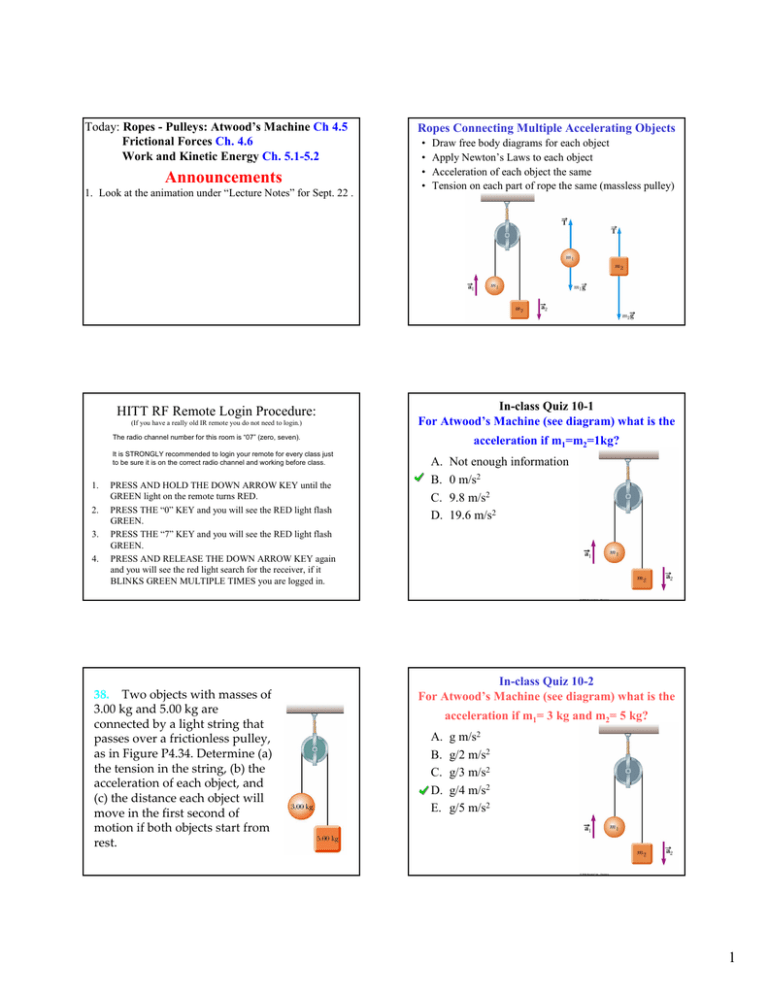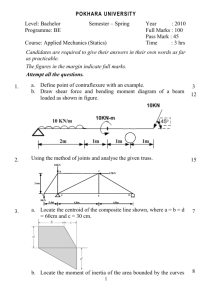Ropes - Pulleys: Atwood’s Machine Frictional Forces Work and Kinetic Energy Ch 4.5
advertisement

Today: Ropes - Pulleys: Atwood’s Machine Ch 4.5 Frictional Forces Ch. 4.6 Work and Kinetic Energy Ch. 5.1-5.2 Announcements 1. Look at the animation under “Lecture Notes” for Sept. 22 . HITT RF Remote Login Procedure: (If you have a really old IR remote you do not need to login.) Ropes Connecting Multiple Accelerating Objects • • • • Draw free body diagrams for each object Apply Newton’s Laws to each object Acceleration of each object the same Tension on each part of rope the same (massless pulley) In-class Quiz 10-1 For Atwood’s Machine (see diagram) what is the The radio channel number for this room is “07” (zero, seven). It is STRONGLY recommended to login your remote for every class just to be sure it is on the correct radio channel and working before class. 1. 2. 3. 4. PRESS AND HOLD THE DOWN ARROW KEY until the GREEN light on the remote turns RED. PRESS THE “0” KEY and you will see the RED light flash GREEN. PRESS THE “7” KEY and you will see the RED light flash GREEN. PRESS AND RELEASE THE DOWN ARROW KEY again and you will see the red light search for the receiver, if it BLINKS GREEN MULTIPLE TIMES you are logged in. 38. Two objects with masses of 3.00 kg and 5.00 kg are connected by a light string that passes over a frictionless pulley, as in Figure P4.34. Determine (a) the tension in the string, (b) the acceleration of each object, and (c) the distance each object will move in the first second of motion if both objects start from rest. acceleration if m1=m2=1kg? A. B. C. D. Not enough information 0 m/s2 9.8 m/s2 19.6 m/s2 In-class Quiz 10-2 For Atwood’s Machine (see diagram) what is the acceleration if m1= 3 kg and m2= 5 kg? A. B. C. D. E. g m/s2 g/2 m/s2 g/3 m/s2 g/4 m/s2 g/5 m/s2 1 Forces of Friction Contact between bodies with a relative velocity produces friction Friction is proportional to the normal force The force of static friction is generally greater than ƒk = µ n Static Friction ƒs • Static friction acts to keep the object from moving • If F increases, so does ƒs • If F decreases, so does ƒs the force of kinetic friction The coefficient of friction (µ-->mu) depends on the surfaces in contact uur uur f s = -F The direction of the frictional force is opposite the direction of motion Or the direction it would move Coefficients of friction are nearly independent of the area of contact In-class Quiz 10-4 For a block sliding down a plane the frictional force is pointed-- Kinetic Friction, ƒk • The force of kinetic friction acts when the object is in motion • ƒk = µ n – Direction of ƒk opposite to motion: opposes motion – Variations of coefficient of friction with speed will be ignored Block on a Ramp 1. 2. 3. 4. Normal to the plane Down the plane Up the plane Can not be determined Chapter 5.1-5.2 Energy and Work • Axes are rotated as usual on an incline • The direction of impending motion would be down the plane • Friction acts up the plane – Opposes the motion • Draw Free Body diagram yada yada yada •Mechanical Energy •Kinetic (associated with motion) •Potential (associated with position) •Chemical Energy •Electromagnetic Energy •Nuclear Energy Energy can be transformed from one form to another But not destroyed--Conserved Work/Energy can be used in place of Newton’s laws to solve certain problems more simply 2




